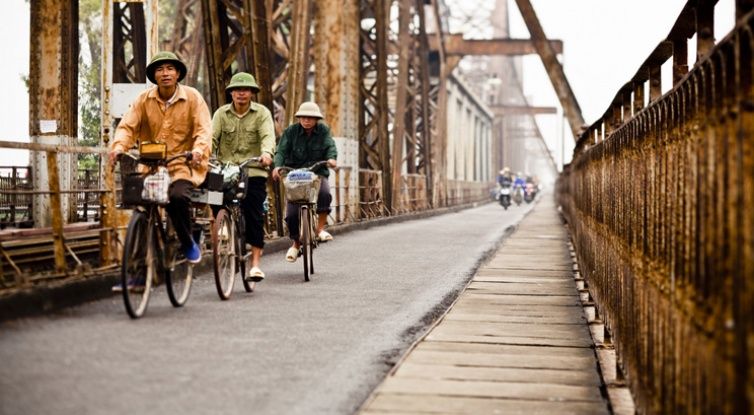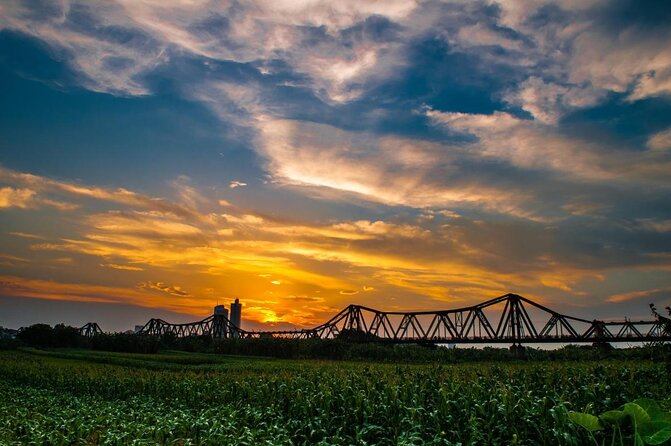Top experience you may interested in:
- Hue to Hoi An motorbike tour via Hai Van pass
- Hue to Hoi An motorbike rental
- Hoi An to Hue motorbike rental
Long Bien Bridge – An Iconic Landmark of Hanoi with Unique Beauty
Long Bien Bridge is often considered a “witness of history,” having stood alongside Hanoi through its ups and downs, significant events, and now becoming a fascinating attraction for tourists with its ancient architecture and beautiful landscapes.
Walking across Long Bien Bridge, observing the bustling flow of people, and admiring the picturesque moments of the Red River flowing by is an experience not to be missed when visiting Hanoi. This article will delve into the historical stories, architecture, and unique experiences of one of the capital city’s iconic symbols.
 Introduction to Long Bien Bridge
Introduction to Long Bien Bridge
The Historical Journey of Long Bien Bridge
Long Bien Bridge has witnessed two national resistance wars against the French and the Americans, marking heroic milestones and unforgettable events. On September 2, 1945, the bridge guided people to the capital city, where they witnessed President Ho Chi Minh read the Declaration of Independence at Ba Dinh Square.
The bridge was also there when the last French soldiers withdrew from Hanoi following the Geneva Agreement in October 1954. During the resistance against the Americans, the bridge played a crucial role in directing troops to the South. As a result, it became a prime target for American airstrikes and bombings.
The Vietnamese People’s Army valiantly defended the bridge, using it as a high-angle artillery base to counter the American airstrikes and gradually take control of the battlefield. In peacetime, Long Bien Bridge became a vital transportation route, meeting the commuting and trading needs of people on both sides of the Red River.
When Was Long Bien Bridge Constructed?
Construction of Long Bien Bridge in Hanoi was initiated by the French administration on September 12, 1898, to facilitate colonial exploitation. After more than 3 years, the bridge was completed on February 3, 1902, and the inauguration ceremony took place on February 28, 1902. At that time, the bridge was named after the Indochina Governor-General Paul Doumer but later renamed Long Bien Bridge by Hanoi Mayor Tran Van Lai in 1945.
Location of Long Bien Bridge and Transportation Tips
Long Bien Bridge spans the Red River, connecting Hoan Kiem District, Ba Dinh District, and Long Bien District in Hanoi. Although it is close to Hanoi’s Old Quarter, getting to the bridge can be challenging during peak hours from 6:00 AM to 9:00 AM and 4:00 PM to 7:30 PM due to heavy traffic congestion.
For a smoother and more enjoyable visit, it is advisable to park your vehicle nearby and walk to the bridge. Alternatively, you can take buses with stops near the bridge, such as bus routes 01, 18, 34, 36 CT, 41, 50, and 55B.
The Unique Architecture of Long Bien Bridge
Long Bien Bridge stretches 2,290 meters over the river, with a span of 896 meters, consisting of 19 steel arches and 20 tall piers. At the time of its inauguration, the bridge was compared to a horizontal Eiffel Tower, ranking as the world’s second-longest bridge, only after the Brooklyn Bridge in the United States.
The bridge is 4.75 meters wide, divided into three lanes – a single railway in the middle, and two lanes on each side for cars, motorcycles, bicycles, and pedestrians. The architectural design harmoniously combines multiple layers resembling a winding dragon, showcasing both strength and elegance. The entire structure is made of high-quality steel using modern construction techniques, ensuring aesthetics and safety.
Today, Hanoi has several other bridges crossing the Red River, such as Chuong Duong Bridge, Thang Long Bridge, Thanh Tri Bridge, Vinh Tuy Bridge, and Nhat Tan Bridge. However, Long Bien Bridge remains an irreplaceable symbol of the capital city due to its ancient architecture and over 120 years of historical significance.
With its historical value and antique architecture, adorned by the marks of time, Long Bien Bridge is a famous attraction in Hanoi, attracting both tourists and locals seeking to enjoy the scenery and fresh air. Here are some exciting experiences you can enjoy during your visit:
Check-In at Long Bien Bridge
Don’t forget to capture nostalgic photos on this historical bridge during your visit. The vast view of the Red River or the rocky banks with lush greenery can also create impressive pictures. However, be cautious and mindful of passing vehicles for safety while taking photos.
Dating and Enjoying the Breeze on the Bridge
With its open space and refreshing breeze, Long Bien Bridge is a favorite dating spot and a perfect place to enjoy the wind. Walking on the bridge, observing the flow of people and vehicles passing by, can help ease stress and worries.
Admiring the Scenic View from Above
The scenery from the bridge changes with the seasons and offers different emotions to each person. You can enjoy the expansive view of the Red River with the wind rustling in your ears and the vast, open sky. Especially during sunrise or sunset, the scene from the bridge becomes even more enchanting. You can also gaze far into the distance to admire the modern Chuong Duong Bridge and the splendid panorama of the capital city.
In conclusion, Long Bien Bridge in Hanoi stands tall as a testament to history and an exquisite piece of architecture. Its remarkable past and unique charm make it a must-visit destination for anyone exploring the capital city. Walk on this iconic bridge, experience its timeless beauty, and immerse yourself in the captivating stories of Hanoi.
Top attraction to visit in Ha Noi





